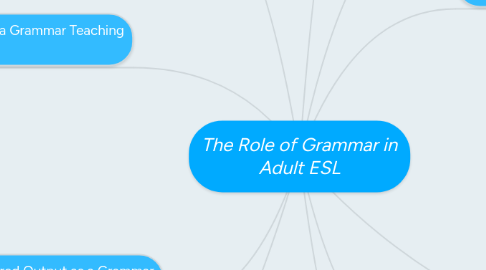
1. Structured Input as a Grammar Teaching Model
1.1. Input instruction as another kind of grammar model. With this kind of instruction, the students’ attention is guided and focused when they process the input. They suggest that grammar instruction should first occur at the level of processing input.
1.1.1. Types of Structured Input Activities: - Binary Options (True/False, Logical/Illogical, Normal/Strange, etc.) - Matching columns - Selecting Alternatives (multiple choice) - Supplying Information (sentence completion)
2. Consiousness raising as a grammar teaching model
2.1. Consciousness is commonly equated with awareness in common usage as well as theoretical treatments.
2.1.1. Types of consciousness raising activities
2.1.1.1. 1. Identify/consolidate. Students are asked to search a set of data to identify a particular pattern or usage and the language forms associated with it.
2.1.1.1.1. 2. Classify (semantic; structural). Students are required to work with a set of data and sort it according to similarities and differences based on formal or semantic criteria.
3. Structured Output as a Grammar Model
3.1. Speaking and writing involve processes to “make output”. These processes include access (retrieval of correct forms), monitoring (editing one’s speech when one realizes “something is wrong”) and production strategies (stringing forms and words together to make sentences), and are affected by a variety of factors
3.1.1. Output activities have two major characteristics: 1. They involve the exchange of previously unknown information. 2. They require students to access a particular form of structure in order to express meaning.
3.1.1.1. The Guidelines for the development of structured output activities are: 1. Preset one grammar point at a time. 2. Keep meaning in focus. 3. Move from sentences to connected discourse. 4. Use both oral and written output. 5. Others must respond to the content of the output. 6. The learner must have some knowledge of the form or structure.
4. Error correction as a grammar teaching model
4.1. Our main goal in teaching the target language forms is to enable our students to produce the language correctly.
4.1.1. Grammar lessons are organized so that the students are induced to make errors, which are immediately corrected by the teacher.
5. An Eclectic Approach to Teaching Grammar.
5.1. Students might learn about grammar, sounds, and vocabulary, but probably they will never be required to use it in meaningful communication.
5.2. Grammar-based and communicative – have elements that complement each other. When combined, they can result in an eclectic approach that is effective in teaching grammar.
6. Semantic fields model
6.1. Vocabulary plays an important role while teaching or learning a foreign language, since it often consists of several hundred thousand words, due to this fact, teachers must resort to strategic routes so as to learners pick up as many words as possible effectively
6.1.1. It is of great importance to make the difference between semantic fields and lexical fields, the former are considered as divisions within the general semantic space of a language so as to have the world worded since the focus is on abstract concepts
6.1.1.1. Matrices
6.1.1.1.1. The matrices consist of a list of features or properties on the horizontal axis and a set of words related by some common component of meaning on the vertical axis.
7. This TBI belongs to meaning-based approaches in which you will notice the following characteristics: * The teacher should avoid controlling learner´s language. * The success of the task depends entirely on the communication achievement. * The teacher is the main source in helping students to shape and clarify what they want to say.
7.1. Teachers have to bear in mind that the most important in TBI is the communication success
8. Content-based instruction
8.1. In this model, the language teacher’s primary goal is to help students develop communicative competence, which is defined as the ability to use the language effectively, appropriately and accurately in social, academic or professional settings, despite limitations in knowledge.
8.1.1. The teacher introduces concepts and terminology for a given subject area, to reinforce content-area information, and to teach specific learning strategies for listening, reading, speaking and writing, reading by means of interesting content.
8.1.1.1. Content-based instruction is helpful at all levels, but the nature of the content differs according to student proficiency level.
8.1.1.1.1. There are three different models of content-based instruction, which integrate the language skills:

